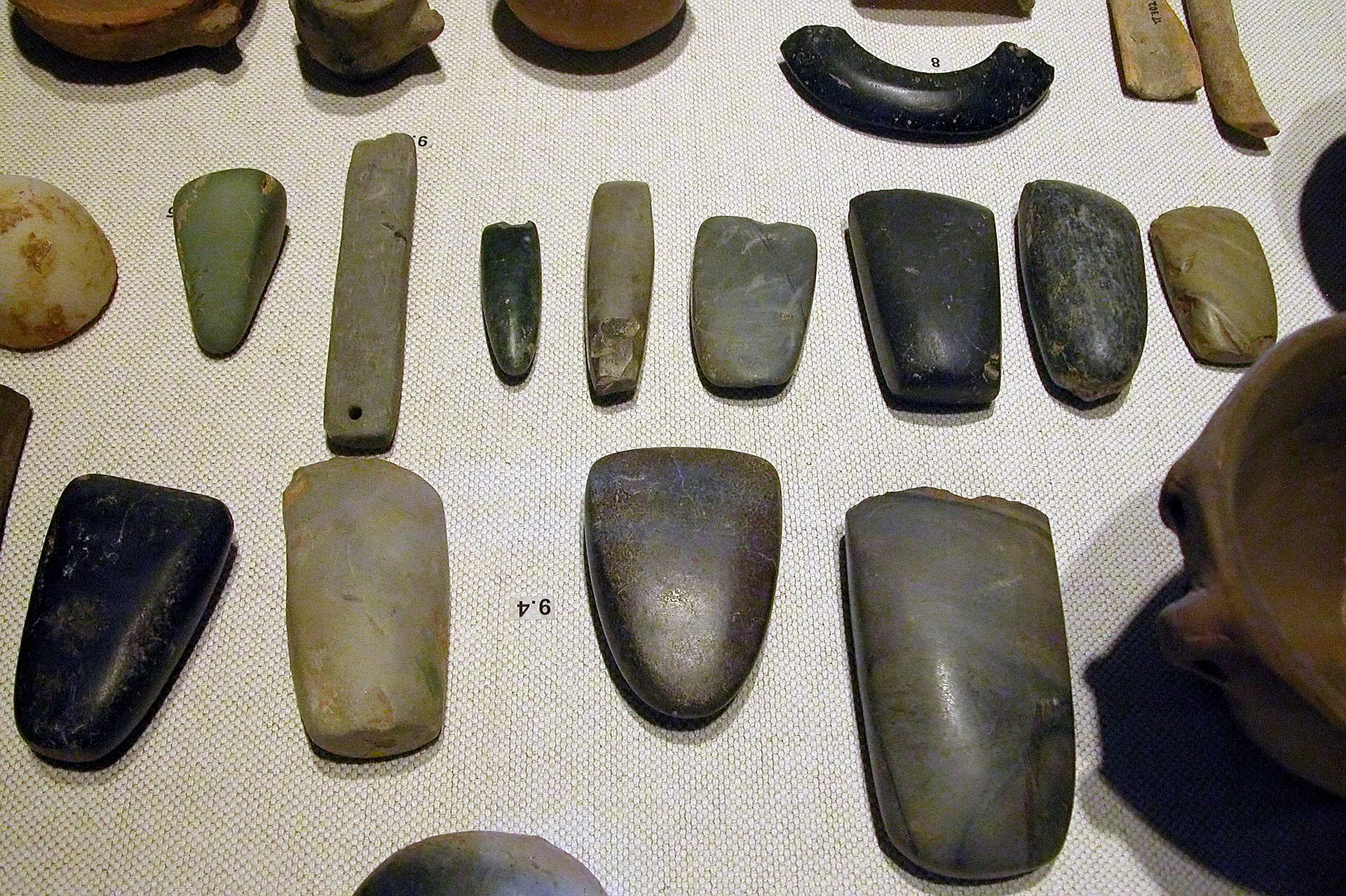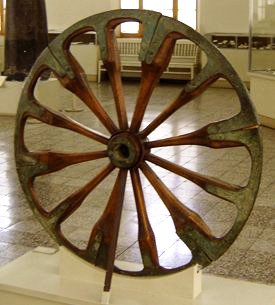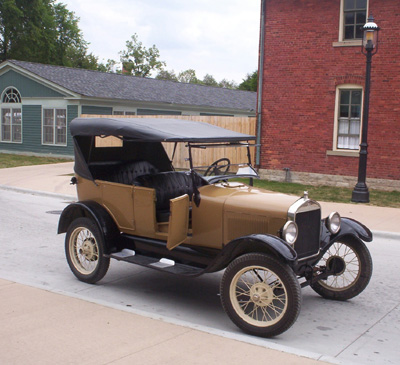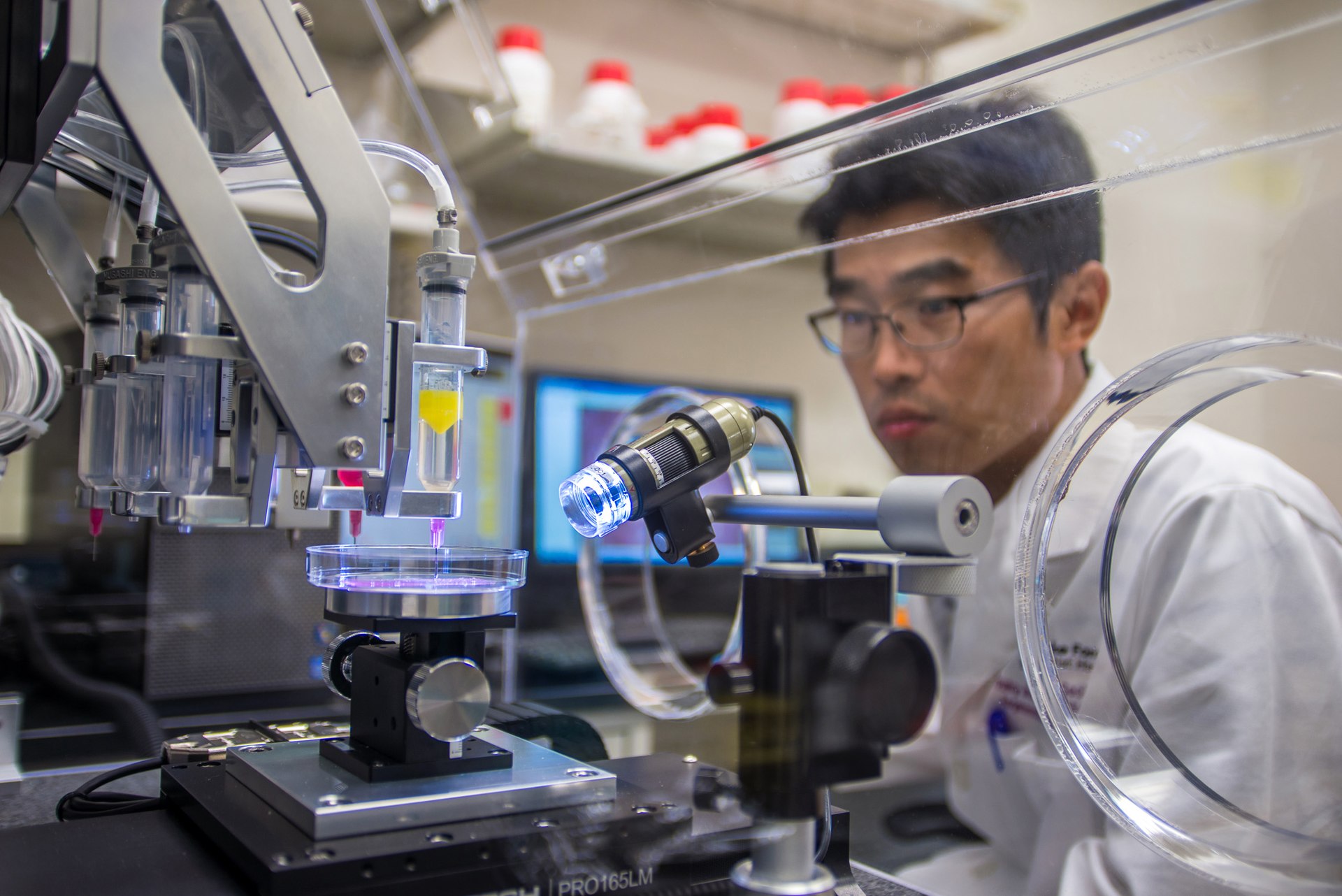
テクノロジー
Technology
ペ
ラギウス, 354-420/440
●再帰的構造としてのテクノロジー
技術(テクノロジー; Technology)とは、実用的な目標を達成するために、特に再現可能な方法で、概念的な知識を応用することである(ウィ キペディア英語「テクノロジー」)
アーサー・ブライアン(2010)によるテクノロ ジーの定義は次のようなものだ:「テクノロジーは、アセンブリと下位アセンブリというパーツからなりたち、そのパーツ自身もテクノロジーである。テクノロ ジーは再帰的構造をもつ」(邦訳, p.8 参照)
そして、ブライアンによる、テクノロジーの3つの原 理とは次のようなものだ;1)テクノロジーはすべての要素の組み合わせである、2)それぞれの要素それ自体がテクノロジーである、3)テクノロジーは何ら かの目的において現象(=自然)を模倣している。
The nature of technology : what it is and
how it evolves, by Arthur, W. Brian, 2010
++
| Technology is the
application of conceptual knowledge for achieving practical goals,
especially in a reproducible way.[1] The word technology can also mean
the products resulting from such efforts,[2][3] including both tangible
tools such as utensils or machines, and intangible ones such as
software. Technology plays a critical role in science, engineering, and
everyday life. Technological advancements have led to significant changes in society. The earliest known technology is the stone tool, used during prehistoric times, followed by the control of fire, which contributed to the growth of the human brain and the development of language during the Ice Age. The invention of the wheel in the Bronze Age allowed greater travel and the creation of more complex machines. More recent technological inventions, including the printing press, telephone, and the Internet, have lowered barriers to communication and ushered in the knowledge economy. While technology contributes to economic development and improves human prosperity, it can also have negative impacts like pollution and resource depletion, and can cause social harms like technological unemployment resulting from automation. As a result, there are ongoing philosophical and political debates about the role and use of technology, the ethics of technology, and ways to mitigate its downsides. |
技
術(Technology)とは、実用的な目標を達成するために、特に再現可能な方法で、概念的な知識を応用することで
ある[1]。技術という言葉には、そのような
努力の結果生み出される産物という意味もあり[2][3]、道具や機械などの有形のものから、ソフトウェアなどの無形のものまで含まれる。テクノロジー
は、科学、工学、そして日常生活において重要な役割を果たしている。 技術の進歩は社会に大きな変化をもたらしてきた。最も古い技術として知られているのは、先史時代に使われた石器であり、次いで氷河期に人間の脳の成長と言 語の発達に貢献した火の制御がある。青銅器時代には車輪が発明され、移動が容易になり、より複雑な機械が作られるようになった。印刷機、電話、インター ネットなど、最近の技術発明はコミュニケーションの障壁を低くし、知識経済の到来を告げた。 テクノロジーは経済発展に貢献し、人類の繁栄を向上させる一方で、公害や資源の枯渇といった負の影響をもたらすこともあり、自動化による技術的失業のよう な社会的弊害を引き起こすこともある。その結果、テクノロジーの役割と利用、テクノロジーの倫理、そしてその弊害を軽減する方法について、哲学的・政治的 な議論が続いている。 |
| Etymology Technology is a term dating back to the early 17th century that meant 'systematic treatment' (from Greek Τεχνολογία, from the Greek: τέχνη, romanized: tékhnē, lit. 'craft, art' and -λογία, 'study, knowledge').[4][5] It is predated in use by the Ancient Greek word tékhnē, used to mean 'knowledge of how to make things', which encompassed activities like architecture.[6] Starting in the 19th century, continental Europeans started using the terms Technik (German) or technique (French) to refer to a 'way of doing', which included all technical arts, such as dancing, navigation, or printing, whether or not they required tools or instruments.[7] At the time, Technologie (German and French) referred either to the academic discipline studying the "methods of arts and crafts", or to the political discipline "intended to legislate on the functions of the arts and crafts."[8] Since the distinction between Technik and Technologie is absent in English, both were translated as technology. The term was previously uncommon in English and mostly referred to the academic discipline, as in the Massachusetts Institute of Technology.[9] In the 20th century, as a result of scientific progress and the Second Industrial Revolution, technology stopped being considered a distinct academic discipline and took on its current-day meaning: the systemic use of knowledge to practical ends.[10] |
語源 テクノロジー(Technology)は、17世紀初頭に遡る用語で、「体系的な治療」を意味する(ギリシャ語のΤεχνολογία、ギリシャ語: τέχνη、ローマ字表記: tékhnē、「工芸、芸術」、-λογία、「学問、知識」に由来する)[4][5]。 4][5]古代ギリシア語のtékhnēに先行して使用されて おり、建築のような活動を包含する「物の作り方の知識」という意味で使用されていた[6]。 19世紀以降、ヨーロッパ大陸の人々はTechnik(ドイツ語)やtechnique(フランス語)という言葉を「やり方」を指す言葉として使い始め、 ダンス、航海術、印刷術など、道具や器具を必要とするか否かにかかわらず、あらゆる技術的な芸術を含むようになった[7]。当時、Technologie (ドイツ語およびフランス語)は「芸術や工芸の方法」を研究する学問分野、または「芸術や工芸の機能を法制化することを目的とした」政治的な学問分野のい ずれかを指していた[8]。この用語は以前は英語では一般的ではなく、マサチューセッツ工科大学のように学問分野を指すことがほとんどであった[9]。 20世紀には、科学の進歩と第二次産業革命の結果として、テクノロジーは明確な学問分野と見なされなくなり、実用的な目的のために知識を体系的に使用する という現在の意味を持つようになった[10]。 |
| History Main articles: History of technology and Timeline of historic inventions Prehistoric Main article: Prehistoric technology refer to caption  A person holding a hand axe Tools were initially developed by hominids through observation and trial and error.[11] Around 2 Mya (million years ago), they learned to make the first stone tools by hammering flakes off a pebble, forming a sharp hand axe.[12] This practice was refined 75 kya (thousand years ago) into pressure flaking, enabling much finer work.[13] The discovery of fire was described by Charles Darwin as "possibly the greatest ever made by man".[14] Archaeological, dietary, and social evidence point to "continuous [human] fire-use" at least 1.5 Mya.[15] Fire, fueled with wood and charcoal, allowed early humans to cook their food to increase its digestibility, improving its nutrient value and broadening the number of foods that could be eaten.[16] The cooking hypothesis proposes that the ability to cook promoted an increase in hominid brain size, though some researchers find the evidence inconclusive.[17] Archaeological evidence of hearths was dated to 790 kya; researchers believe this is likely to have intensified human socialization and may have contributed to the emergence of language.[18][19] Other technological advances made during the Paleolithic era include clothing and shelter.[20] No consensus exists on the approximate time of adoption of either technology, but archaeologists have found archaeological evidence of clothing 90-120 kya[21] and shelter 450 kya.[20] As the Paleolithic era progressed, dwellings became more sophisticated and more elaborate; as early as 380 kya, humans were constructing temporary wood huts.[22][23] Clothing, adapted from the fur and hides of hunted animals, helped humanity expand into colder regions; humans began to migrate out of Africa around 200 kya, initially moving to Eurasia.[24][25][26] Neolithic Main article: Neolithic Revolution  Photo of Neolithic tools on display An array of Neolithic artifacts, including bracelets, axe heads, chisels, and polishing tools The Neolithic Revolution (or First Agricultural Revolution) brought about an acceleration of technological innovation, and a consequent increase in social complexity.[27] The invention of the polished stone axe was a major advance that allowed large-scale forest clearance and farming.[28] This use of polished stone axes increased greatly in the Neolithic but was originally used in the preceding Mesolithic in some areas such as Ireland.[29] Agriculture fed larger populations, and the transition to sedentism allowed for the simultaneous raising of more children, as infants no longer needed to be carried around by nomads. Additionally, children could contribute labor to the raising of crops more readily than they could participate in hunter-gatherer activities.[30][31] With this increase in population and availability of labor came an increase in labor specialization.[32] What triggered the progression from early Neolithic villages to the first cities, such as Uruk, and the first civilizations, such as Sumer, is not specifically known; however, the emergence of increasingly hierarchical social structures and specialized labor, of trade and war amongst adjacent cultures, and the need for collective action to overcome environmental challenges such as irrigation, are all thought to have played a role.[33] The invention of writing led to the spread of cultural knowledge and became the basis for history, libraries, schools, and scientific research.[34] Continuing improvements led to the furnace and bellows and provided, for the first time, the ability to smelt and forge gold, copper, silver, and lead – native metals found in relatively pure form in nature.[35] The advantages of copper tools over stone, bone and wooden tools were quickly apparent to early humans, and native copper was probably used from near the beginning of Neolithic times (about 10 ka).[36] Native copper does not naturally occur in large amounts, but copper ores are quite common and some of them produce metal easily when burned in wood or charcoal fires. Eventually, the working of metals led to the discovery of alloys such as bronze and brass (about 4,000 BCE). The first use of iron alloys such as steel dates to around 1,800 BCE.[37][38] Ancient Main article: Ancient technology  Photo of an early wooden wheel The wheel was invented c. 4,000 BCE. After harnessing fire, humans discovered other forms of energy. The earliest known use of wind power is the sailing ship; the earliest record of a ship under sail is that of a Nile boat dating to around 7,000 BCE.[39] From prehistoric times, Egyptians likely used the power of the annual flooding of the Nile to irrigate their lands, gradually learning to regulate much of it through purposely built irrigation channels and "catch" basins.[40] The ancient Sumerians in Mesopotamia used a complex system of canals and levees to divert water from the Tigris and Euphrates rivers for irrigation.[41] Archaeologists estimate that the wheel was invented independently and concurrently in Mesopotamia (in present-day Iraq), the Northern Caucasus (Maykop culture), and Central Europe.[42] Time estimates range from 5,500 to 3,000 BCE with most experts putting it closer to 4,000 BCE.[43] The oldest artifacts with drawings depicting wheeled carts date from about 3,500 BCE.[44] More recently, the oldest-known wooden wheel in the world was found in the Ljubljana Marsh of Slovenia.[45] The invention of the wheel revolutionized trade and war. It did not take long to discover that wheeled wagons could be used to carry heavy loads. The ancient Sumerians used a potter's wheel and may have invented it.[46] A stone pottery wheel found in the city-state of Ur dates to around 3,429 BCE,[47] and even older fragments of wheel-thrown pottery have been found in the same area.[47] Fast (rotary) potters' wheels enabled early mass production of pottery, but it was the use of the wheel as a transformer of energy (through water wheels, windmills, and even treadmills) that revolutionized the application of nonhuman power sources. The first two-wheeled carts were derived from travois[48] and were first used in Mesopotamia and Iran in around 3,000 BCE.[48] The oldest known constructed roadways are the stone-paved streets of the city-state of Ur, dating to c. 4,000 BCE,[49] and timber roads leading through the swamps of Glastonbury, England, dating to around the same period.[49] The first long-distance road, which came into use around 3,500 BCE,[49] spanned 2,400 km from the Persian Gulf to the Mediterranean Sea,[49] but was not paved and was only partially maintained.[49] In around 2,000 BCE, the Minoans on the Greek island of Crete built a 50 km road leading from the palace of Gortyn on the south side of the island, through the mountains, to the palace of Knossos on the north side of the island.[49] Unlike the earlier road, the Minoan road was completely paved.[49]  Photograph of the Pont du Gard in France, one of the most famous ancient Roman aqueducts[50] Ancient Minoan private homes had running water.[51] A bathtub virtually identical to modern ones was unearthed at the Palace of Knossos.[51][52] Several Minoan private homes also had toilets, which could be flushed by pouring water down the drain.[51] The ancient Romans had many public flush toilets,[52] which emptied into an extensive sewage system.[52] The primary sewer in Rome was the Cloaca Maxima;[52] construction began on it in the sixth century BCE and it is still in use today.[52] The ancient Romans also had a complex system of aqueducts,[50] which were used to transport water across long distances.[50] The first Roman aqueduct was built in 312 BCE.[50] The eleventh and final ancient Roman aqueduct was built in 226 CE.[50] Put together, the Roman aqueducts extended over 450 km,[50] but less than 70 km of this was above ground and supported by arches.[50] Pre-modern Main articles: Medieval technology and Renaissance technology Innovations continued through the Middle Ages with the introduction of silk production (in Asia and later Europe), the horse collar, and horseshoes. Simple machines (such as the lever, the screw, and the pulley) were combined into more complicated tools, such as the wheelbarrow, windmills, and clocks.[53] A system of universities developed and spread scientific ideas and practices, including Oxford and Cambridge.[54] The Renaissance era produced many innovations, including the introduction of the movable type printing press to Europe, which facilitated the communication of knowledge. Technology became increasingly influenced by science, beginning a cycle of mutual advancement.[55] Modern Main articles: Industrial Revolution, Second Industrial Revolution, and Information Age  Photo of a Ford Model T on a road The automobile revolutionized personal transportation. Starting in the United Kingdom in the 18th century, the discovery of steam power set off the Industrial Revolution, which saw wide-ranging technological discoveries, particularly in the areas of agriculture, manufacturing, mining, metallurgy, and transport, and the widespread application of the factory system.[56] This was followed a century later by the Second Industrial Revolution which led to rapid scientific discovery, standardization, and mass production. New technologies were developed, including sewage systems, electricity, light bulbs, electric motors, railroads, automobiles, and airplanes. These technological advances led to significant developments in medicine, chemistry, physics, and engineering.[57] They were accompanied by consequential social change, with the introduction of skyscrapers accompanied by rapid urbanization.[58] Communication improved with the invention of the telegraph, the telephone, the radio, and television.[59] The 20th century brought a host of innovations. In physics, the discovery of nuclear fission in the Atomic Age led to both nuclear weapons and nuclear power. Analog computers were invented and asserted dominance in processing complex data. While the invention of vacuum tubes allowed for digital computing with computers like the ENIAC, their sheer size precluded widespread use until innovations in quantum physics allowed for the invention of the transistor in 1947, which significantly compacted computers and led the digital transition. Information technology, particularly optical fiber and optical amplifiers, allowed for simple and fast long-distance communication, which ushered in the Information Age and the birth of the Internet. The Space Age began with the launch of Sputnik 1 in 1957, and later the launch of crewed missions to the moon in the 1960s. Organized efforts to search for extraterrestrial intelligence have used radio telescopes to detect signs of technology use, or technosignatures, given off by alien civilizations. In medicine, new technologies were developed for diagnosis (CT, PET, and MRI scanning), treatment (like the dialysis machine, defibrillator, pacemaker, and a wide array of new pharmaceutical drugs), and research (like interferon cloning and DNA microarrays).[60] Complex manufacturing and construction techniques and organizations are needed to make and maintain more modern technologies, and entire industries have arisen to develop succeeding generations of increasingly more complex tools. Modern technology increasingly relies on training and education – their designers, builders, maintainers, and users often require sophisticated general and specific training.[61] Moreover, these technologies have become so complex that entire fields have developed to support them, including engineering, medicine, and computer science; and other fields have become more complex, such as construction, transportation, and architecture. |
沿革 主な記事 技術の歴史と歴史的発明の年表 先史時代 主な記事 先史時代の技術 キャプションを参照する  手斧を持つ人 道具は当初、ヒト科の動物が観察と試行錯誤を通じて開発したものであった[11]。2ミヤ(100万年前)頃、彼らは小石から薄片をハンマーで叩いて鋭利 な手斧を作り、最初の石器を作ることを学んだ[12]。 火の発見は、チャールズ・ダーウィンによって「おそらく人類史上最大の発見」と評された[14]。考古学的、食生活的、社会的な証拠から、少なくとも 1.5ミヤ(1.5千年前)には「継続的な(人類の)火の使用」があったとされている[15]。 [16]調理仮説は、調理能力がヒト科動物の脳の大きさの増加を促進したと提唱しているが、一部の研究者はその証拠を決定的なものではないと見なしてい る。[17]囲炉裏の考古学的証拠は790kyaまでさかのぼる。研究者たちは、これが人類の社会化を強化し、言語の出現に貢献した可能性があると考えて いる。 旧石器時代になされたその他の技術的進歩には、衣服とシェルターが含まれる[20]。どちらの技術が採用されたおおよその時期についてコンセンサスは存在 しないが、考古学者は衣服の考古学的証拠を90~120万年[21]、シェルターの考古学的証拠を450万年前に発見している。 [20]旧石器時代が進むにつれて、住居はより洗練され、より精巧になった。早ければ380kyaには、人類は一時的な木造の小屋を建設していた[22] [23]。狩猟した動物の毛皮や皮革から適応した衣服は、人類がより寒い地域に進出するのに役立った。 新石器時代 主な記事 新石器革命  展示されている新石器時代の道具の写真 ブレスレット、斧の頭、ノミ、研磨道具など、新石器時代の遺物の数々。 新石器革命(または第一次農業革命)は、技術革新の加速と、それに伴う社会の複雑化をもたらした[27]。 [農業はより多くの人口を養い、定住への移行は、遊牧民が乳幼児を連れ歩く必要がなくなったため、より多くの子どもを同時に育てることを可能にした。さら に、子どもたちは狩猟採集の活動に参加するよりも容易に農作物の栽培に労働力を提供することができた[30][31]。 新石器時代の初期の村落からウルクのような最初の都市、そしてシュメールのような最初の文明へと発展するきっかけとなったものは具体的にはわかっていない が、階層化された社会構造や専門化された労働力の出現、隣接する文化圏間での交易や戦争、灌漑のような環境上の課題を克服するための集団行動の必要性など が、すべて関与していると考えられている[33]。 文字の発明は文化的知識の普及につながり、歴史、図書館、学校、科学研究の基礎となった[34]。 継続的な改良は炉とふいごにつながり、金、銅、銀、鉛という自然界に比較的純粋な形で存在する金属を精錬し鍛造する能力を初めて提供した。 [銅の道具が石や骨や木の道具よりも優れていることは、初期の人類にはすぐに明らかになり、おそらく新石器時代の初期近く(およそ10Ka)から在来の銅 が使われていた。やがて金属を加工することで、青銅や真鍮などの合金が発見された(紀元前約4,000年)。鋼鉄のような鉄合金の最初の使用は、紀元前 1,800年頃にさかのぼる[37][38]。 古代 主な記事 古代の技術  初期の木製車輪の写真 車輪は紀元前4,000年頃に発明された。 火を利用した後、人類は他のエネルギー形態を発見した。帆を張った船の最古の記録は、紀元前7,000年頃に作られたナイル川の船である[39]。先史時 代から、エジプト人はナイル川の毎年の氾濫の力を利用して土地を灌漑していたと思われ、次第に意図的に作られた灌漑用水路と「受け皿」によってその多くを 調整することを学んだ。 [40] メソポタミアの古代シュメール人は、灌漑のためにチグリス川とユーフラテス川から水を迂回させるために、運河と堤防の複雑なシステムを使用していた [41]。 考古学者の推定では、車輪はメソポタミア(現在のイラク)、北コーカサス(メイコップ文化)、中央ヨーロッパで独立して同時に発明された[42]。 [最近では、スロベニアのリュブリャナ湿原で世界最古の木製の車輪が発見された[44]。 車輪の発明は、貿易と戦争に革命をもたらした。車輪付きの荷車が重い荷物を運ぶのに使えることが発見されるのに時間はかからなかった。古代シュメール人は ろくろを使用しており、それを発明した可能性もある[46]。都市国家ウルで発見された石製のろくろは紀元前3,429年頃のものであり[47]、同じ地 域でさらに古いろくろで挽かれた陶器の破片が発見されている[47]。高速(回転式)ろくろは初期の陶器の大量生産を可能にしたが、人間以外の動力源の応 用に革命をもたらしたのは、(水車、風車、さらにはルームランナーを通じて)エネルギーの変圧器としてのろくろの使用であった。最初の二輪馬車はトラボア [48]から派生したもので、紀元前3,000年頃にメソポタミアとイランで初めて使用された[48]。 知られている最古の建設道路は、紀元前4,000年頃の都市国家ウルの石畳の道であり[49]、同時期のイギリスのグラストンベリーの沼地を通る木造の道 である[49]。 紀元前3,500年頃に使用されるようになった最初の長距離道路[49]は、ペルシャ湾から地中海まで2,400kmに及んだが[49]、舗装されておら ず、部分的にしか整備されていなかった。 [49]紀元前2,000年頃、ギリシャのクレタ島のミノア人は、島の南側にあるゴルティンの宮殿から山を通って島の北側にあるクノッソスの宮殿へと続く 50kmの道路を建設した[49]。以前の道路とは異なり、ミノアの道路は完全に舗装されていた[49]。  フランスのポン・デュ・ガールの写真。最も有名な古代ローマの水道橋のひとつである[50]。 古代ミノアの民家には水道があった[51]。クノッソス宮殿からは、現代のものとほぼ同じ浴槽が発掘された[51][52]。いくつかのミノアの民家には トイレもあり、排水溝に水を流して流すことができた。 [51]古代ローマには多くの公共の水洗トイレがあり[52]、それらは大規模な下水システムに注ぎ込まれていた[52]。ローマの主要な下水道はクロア カ・マキシマ(Cloaca Maxima)であり[52]、紀元前6世紀に建設が開始され、現在も使用されている[52]。 古代ローマには複雑な水道橋のシステムもあり[50]、長距離の水の運搬に使用されていた[50]。最初のローマ水道橋は紀元前312年に建設された [50]。 前近代 主な記事 中世の技術とルネサンスの技術 絹の生産(アジアと後のヨーロッパ)、馬の首輪、蹄鉄の導入など、中世を通じて技術革新は続いた。単純な機械(てこ、ねじ、滑車など)は、手押し車、風 車、時計などのより複雑な道具に組み合わされた[53]。オックスフォードやケンブリッジなどの大学のシステムが発展し、科学的な考え方や実践が広まった [54]。 ルネサンス時代には、知識の伝達を容易にする可動式活版印刷機がヨーロッパに導入されるなど、多くの革新がもたらされた。技術はますます科学の影響を受け るようになり、相互の進歩のサイクルが始まった[55]。 近代 主な記事 産業革命、第二次産業革命、情報化時代  道路を走るT型フォードの写真 自動車は個人の移動手段に革命をもたらした。 18世紀にイギリスで始まった蒸気動力の発見は産業革命を引き起こし、特に農業、製造業、鉱業、冶金、輸送の分野で幅広い技術的発見がなされ、工場制度が 広く適用された[56]。下水道、電気、電球、電気モーター、鉄道、自動車、飛行機などの新技術が開発された。こうした技術の進歩は、医学、化学、物理 学、工学の分野での重要な発展につながった[57]。急速な都市化に伴う超高層ビルの導入など、結果的な社会的変化も伴っていた[58]。 20世紀には多くの技術革新がもたらされた。物理学では、原子時代に核分裂が発見され、核兵器と原子力発電が生まれた。アナログ・コンピュータが発明さ れ、複雑なデータの処理において優位を占めるようになった。真空管の発明により、ENIACのようなコンピュータでデジタル計算が可能になったが、量子物 理学の革新により1947年にトランジスタが発明され、コンピュータが大幅に小型化され、デジタルへの移行が進むまで、そのサイズの大きさゆえに普及が妨 げられた。情報技術、特に光ファイバーと光増幅器は、シンプルで高速な長距離通信を可能にし、情報化時代の到来とインターネットの誕生を告げた。宇宙時代 は1957年のスプートニク1号の打ち上げで始まり、その後1960年代には有人月探査ミッションが開始された。地球外知的生命体を探索する組織的な取り 組みでは、電波望遠鏡を使って、異星文明が発する技術使用の兆候、すなわちテクノシグネチャーを検出した。医療においては、診断(CT、PET、MRIス キャン)、治療(透析装置、除細動器、ペースメーカー、多種多様な新薬など)、研究(インターフェロン・クローニングやDNAマイクロアレイなど)のため に新技術が開発された[60]。 より近代的な技術を作り、維持するためには、複雑な製造技術や建設技術、組織が必要とされ、産業全体が、ますます複雑化する道具の後継世代を開発するため に生まれてきた。現代技術はますます訓練と教育に依存するようになり、その設計者、構築者、保守者、利用者は、しばしば高度な一般的・特殊な訓練を必要と する[61]。さらに、これらの技術は、工学、医学、コンピュータ科学など、それらをサポートするために分野全体が発展したほど複雑になっており、建設、 輸送、建築など、他の分野もより複雑になっている。 |
| Impact Main article: Technology and society Technological change is the largest cause of long-term economic growth.[62][63] Throughout human history, energy production was the main constraint on economic development, and new technologies allowed humans to significantly increase the amount of available energy. First came fire, which made edible a wider variety of foods, and made it less physically demanding to digest them. Fire also enabled smelting, and the use of tin, copper, and iron tools, used for hunting or tradesmanship. Then came the agricultural revolution: humans no longer needed to hunt or gather to survive, and began to settle in towns and cities, forming more complex societies, with militaries and more organized forms of religion.[64] Technologies have contributed to human welfare through increased prosperity, improved comfort and quality of life, and medical progress, but they can also disrupt existing social hierarchies, cause pollution, and harm individuals or groups. Recent years have brought about a rise in social media's cultural prominence, with potential repercussions on democracy, and economic and social life. Early on, the internet was seen as a "liberation technology" that would democratize knowledge, improve access to education, and promote democracy. Modern research has turned to investigate the internet's downsides, including disinformation, polarization, hate speech, and propaganda.[65] Since the 1970s, technology's impact on the environment has been criticized, leading to a surge in investment in solar, wind, and other forms of clean energy. Social Jobs Since the invention of the wheel, technologies have helped increase humans' economic output. Past automation has both substituted and complemented labor; machines replaced humans at some lower-paying jobs (for example in agriculture), but this was compensated by the creation of new, higher-paying jobs.[66] Studies have found that computers did not create significant net technological unemployment.[67] Due to artificial intelligence being far more capable than computers, and still being in its infancy, it is not known whether it will follow the same trend; the question has been debated at length among economists and policymakers. A 2017 survey found no clear consensus among economists on whether AI would increase long-term unemployment.[68] According to the World Economic Forum's "The Future of Jobs Report 2020", AI is predicted to replace 85 million jobs worldwide, and create 97 million new jobs by 2025.[69][70] From 1990 to 2007, a study in the U.S. by MIT economist Daron Acemoglu showed that an addition of one robot for every 1,000 workers decreased the employment-to-population ratio by 0.2%, or about 3.3 workers, and lowered wages by 0.42%.[71][72] Concerns about technology replacing human labor however are long-lasting. As US president Lyndon Johnson said in 1964, "Technology is creating both new opportunities and new obligations for us, opportunity for greater productivity and progress; obligation to be sure that no workingman, no family must pay an unjust price for progress." upon signing the National Commission on Technology, Automation, and Economic Progress bill.[73][74][75][76][77] Security With the growing reliance of technology, there have been security and privacy concerns along with it. Billions of people use different online payment methods, such as WeChat Pay, PayPal, Alipay, and much more to help transfer money. Although security measures are placed, some criminals are able to bypass them.[78] In March 2022, North Korea used Blender.io, a mixer which helped them to hide their cryptocurrency exchanges, to launder over $20.5 million in cryptocurrency, from Axie Infinity, and steal over $600 million worth of cryptocurrency from the game's owner. Because of this, the U.S. Treasury Department sanctioned Blender.io, which marked the first time it has taken action against a mixer, to try and crack down on North Korean hackers.[79][80] The privacy of cryptocurrency has been debated. Although many customers like the privacy of cryptocurrency, many also argue that it needs more transparency and stability.[78] Environmental Technology has impacted the world with negative and positive environmental impacts, which are usually the reverse of the initial damage, such as; the creation of pollution and the attempt to undo said pollution,[81] deforestation and the reversing of deforestation,[82] and oil spills. All of these have had a significant impact on the environment of the earth. As technology has advanced, so has the negative environmental impact, with the releasing of greenhouse gases, like methane and carbon dioxide, into the atmosphere, causing the greenhouse effect, gradually heating the earth and causing global warming. All of this has become worse with the advancement of technology.[83] Pollution Pollution, the presence of contaminants in an environment that causes adverse effects, could have been present as early as the Inca empire. They used a lead sulfide flux in the smelting of ores, along with the use of a wind-drafted clay kiln, which released lead into the atmosphere and the sediment of rivers.[84] Philosophy Main article: Philosophy of technology Philosophy of technology is a branch of philosophy that studies the "practice of designing and creating artifacts", and the "nature of the things so created."[85] It emerged as a discipline over the past two centuries, and has grown "considerably" since the 1970s.[86] The humanities philosophy of technology is concerned with the "meaning of technology for, and its impact on, society and culture".[85] Initially, technology was seen as an extension of the human organism that replicated or amplified bodily and mental faculties.[87] Marx framed it as a tool used by capitalists to oppress the proletariat, but believed that technology would be a fundamentally liberating force once it was "freed from societal deformations". Second-wave philosophers like Ortega later shifted their focus from economics and politics to "daily life and living in a techno-material culture", arguing that technology could oppress "even the members of the bourgeoisie who were its ostensible masters and possessors." Third-stage philosophers like Don Ihde and Albert Borgmann represent a turn toward de-generalization and empiricism, and considered how humans can learn to live with technology.[86][page needed] Early scholarship on technology was split between two arguments: technological determinism, and social construction. Technological determinism is the idea that technologies cause unavoidable social changes.[88]: 95 It usually encompasses a related argument, technological autonomy, which asserts that technological progress follows a natural progression and cannot be prevented.[89] Social constructivists[who?] argue that technologies follow no natural progression, and are shaped by cultural values, laws, politics, and economic incentives. Modern scholarship has shifted towards an analysis of sociotechnical systems, "assemblages of things, people, practices, and meanings", looking at the value judgments that shape technology.[88][page needed] Cultural critic Neil Postman distinguished tool-using societies from technological societies and from what he called "technopolies", societies that are dominated by an ideology of technological and scientific progress to the detriment of other cultural practices, values, and world views.[90] Herbert Marcuse and John Zerzan suggest that technological society will inevitably deprive us of our freedom and psychological health.[91] Ethics Main article: Ethics of technology The ethics of technology is an interdisciplinary subfield of ethics that analyzes technology's ethical implications and explores ways to mitigate the potential negative impacts of new technologies. There is a broad range of ethical issues revolving around technology, from specific areas of focus affecting professionals working with technology to broader social, ethical, and legal issues concerning the role of technology in society and everyday life.[92] Prominent debates have surrounded genetically modified organisms, the use of robotic soldiers, algorithmic bias, and the issue of aligning AI behavior with human values.[93] Technology ethics encompasses several key fields. Bioethics looks at ethical issues surrounding biotechnologies and modern medicine, including cloning, human genetic engineering, and stem cell research. Computer ethics focuses on issues related to computing. Cyberethics explores internet-related issues like intellectual property rights, privacy, and censorship. Nanoethics examines issues surrounding the alteration of matter at the atomic and molecular level in various disciplines including computer science, engineering, and biology. And engineering ethics deals with the professional standards of engineers, including software engineers and their moral responsibilities to the public.[94] A wide branch of technology ethics is concerned with the ethics of artificial intelligence: it includes robot ethics, which deals with ethical issues involved in the design, construction, use, and treatment of robots,[95] as well as machine ethics, which is concerned with ensuring the ethical behavior of artificially intelligent agents.[96] Within the field of AI ethics, significant yet-unsolved research problems include AI alignment (ensuring that AI behaviors are aligned with their creators' intended goals and interests) and the reduction of algorithmic bias. Some researchers have warned against the hypothetical risk of an AI takeover, and have advocated for the use of AI capability control in addition to AI alignment methods. Other fields of ethics have had to contend with technology-related issues, including military ethics, media ethics, and educational ethics. Futures studies Main article: Futures studies Futures studies is the systematic and interdisciplinary study of social and technological progress. It aims to quantitatively and qualitatively explore the range of plausible futures and to incorporate human values in the development of new technologies.[97]: 54 More generally, futures researchers are interested in improving "the freedom and welfare of humankind".[97]: 73 It relies on a thorough quantitative and qualitative analysis of past and present technological trends, and attempts to rigorously extrapolate them into the future.[97] Science fiction is often used as a source of ideas.[97]: 173 Futures research methodologies include survey research, modeling, statistical analysis, and computer simulations.[97]: 187 Existential risk Main article: Global catastrophic risk Existential risk researchers analyze risks that could lead to human extinction or civilizational collapse, and look for ways to build resilience against them.[98][99] Relevant research centers include the Cambridge Center for the Study of Existential Risk, and the Stanford Existential Risk Initiative.[100] Future technologies may contribute to the risks of artificial general intelligence, biological warfare, nuclear warfare, nanotechnology, anthropogenic climate change, global warming, or stable global totalitarianism, though technologies may also help us mitigate asteroid impacts and gamma-ray bursts.[101] In 2019 philosopher Nick Bostrom introduced the notion of a vulnerable world, "one in which there is some level of technological development at which civilization almost certainly gets devastated by default", citing the risks of a pandemic caused by bioterrorists, or an arms race triggered by the development of novel armaments and the loss of mutual assured destruction.[102] He invites policymakers to question the assumptions that technological progress is always beneficial, that scientific openness is always preferable, or that they can afford to wait until a dangerous technology has been invented before they prepare mitigations.[102] |
インパクト 主な記事 技術と社会 技術革新は、長期的な経済成長の最大の原因である[62][63]。人類の歴史を通じて、エネルギー生産は経済発展の主な制約であったが、新しい技術に よって人類は利用可能なエネルギー量を大幅に増やすことができた。最初に火が登場したことで、食用になる食品の種類が増え、それらを消化するための肉体的 負担が軽減された。火はまた、製錬を可能にし、狩猟や交易に使う錫、銅、鉄の道具の使用を可能にした。その後、農業革命が起こった。人類はもはや狩猟や採 集をする必要がなくなり、町や都市に定住するようになり、軍隊やより組織化された宗教を持つ、より複雑な社会を形成するようになった[64]。 テクノロジーは、繁栄の拡大、快適性や生活の質の向上、医学の進歩を通じて人類の福祉に貢献してきたが、既存の社会階層を崩壊させたり、公害を引き起こし たり、個人や集団に危害を加えたりすることもある。 近年、ソーシャルメディアが文化的に重要視されるようになり、民主主義や経済・社会生活に影響を及ぼす可能性が出てきた。初期には、インターネットは知識 を民主化し、教育へのアクセスを改善し、民主主義を促進する「解放のテクノロジー」とみなされていた。現代の研究は、偽情報、分極化、ヘイトスピーチ、プ ロパガンダなど、インターネットのマイナス面を調査する方向に転じている[65]。 1970年代以降、テクノロジーが環境に与える影響が批判され、太陽光や風力などのクリーンエネルギーへの投資が急増した。 社会 雇用 車輪の発明以来、テクノロジーは人間の経済的生産高を増大させるのに役立ってきた。過去の自動化は、労働の代替と補完の両方を行ってきた。機械が人間に 取って代わった低賃金の仕事(例えば農業)もあったが、これは新しい高賃金の仕事の創出によって補われた[66]。2017年の調査では、AIが長期的な 失業率を増加させるかどうかについて、経済学者の間で明確なコンセンサスが得られていないことがわかった[68]。世界経済フォーラムの「雇用の未来レ ポート2020」によれば、AIは2025年までに世界中で8,500万人の雇用を代替し、9,700万人の新たな雇用を創出すると予測されている [69][70]。 1990年から2007年にかけて、マサチューセッツ工科大学(MIT)のエコノミスト、ダロン・アセモグルによる米国での調査では、労働者1,000人 につき1台のロボットが加わると、雇用人口比は0.2%、つまり約3.3人減少し、賃金は0.42%低下することが示されている[71][72]。 1964年にリンドン・ジョンソン米大統領が、「テクノロジーはわれわれに新たな機会と新たな義務の両方を生み出している。より大きな生産性と進歩のため の機会であり、いかなる労働者も、いかなる家族も、進歩のために不当な代償を支払わなければならないことを確認する義務である」と、テクノロジー、オート メーション、経済進歩に関する国家委員会法案に署名した際に述べている[73][74][75][76][77]。 セキュリティ テクノロジーへの依存が高まるにつれて、セキュリティやプライバシーに関する懸念も生じている。何十億人もの人々が、WeChat Pay、PayPal、Alipayなど、さまざまなオンライン決済手段を利用して送金を行っている。2022年3月、北朝鮮は暗号通貨取引所を隠すのに 役立つミキサーBlender.ioを使って、Axie Infinityから2,050万ドル以上の暗号通貨を洗浄し、ゲームの所有者から6億ドル以上の暗号通貨を盗んだ。このため、米財務省は Blender.ioを制裁し、北朝鮮のハッカーを取り締まろうと、ミキサーに対して初めて行動を起こした。暗号通貨のプライバシーは議論されてきた。暗 号通貨のプライバシーを好む顧客は多いが、暗号通貨にはもっと透明性と安定性が必要だという意見も多い[78]。 環境問題 例えば、公害の発生と公害を元に戻そうとする試み[81]、森林伐採と森林伐採の逆転[82]、石油流出などである。これらはすべて、地球の環境に大きな 影響を与えてきた。技術が進歩するにつれ、環境への悪影響も大きくなり、メタンや二酸化炭素のような温室効果ガスが大気中に放出され、温室効果を引き起こ し、地球を徐々に加熱し、地球温暖化を引き起こしている。こうしたことはすべて、技術の進歩とともに悪化している[83]。 汚染 環境中に汚染物質が存在し、それが悪影響を引き起こすことである公害は、インカ帝国時代にはすでに存在していた可能性がある。彼らは鉱石の製錬に硫化鉛の フラックスを使用し、さらに風力発電の粘土窯を使用したため、大気中や河川の堆積物に鉛が放出された[84]。 哲学 主な記事 技術哲学 技術哲学は哲学の一分野であり、「人工物を設計し創造する実践」と「そうして創造されたものの性質」を研究する[85]。 当初、テクノロジーは、身体的・精神的能力を複製したり増幅したりする人間の有機体の延長として捉えられていた[87]。マルクスは、それを資本家がプロ レタリアートを抑圧するために使用する道具として枠にはめたが、ひとたび「社会の変形から解放」されれば、テクノロジーは根本的に解放する力になると信じ ていた。オルテガのような第二波の哲学者たちはその後、経済や政治から「日常生活とテクノマテリアル文化の中での生活」に焦点を移し、テクノロジーが「そ の表向きの主人であり所有者であるブルジョアジーの構成員でさえも」抑圧しうると主張した。ドン・イェーデやアルバート・ボーグマンのような第三段階の哲 学者たちは、脱一般化と経験主義への転換を象徴するものであり、人間がいかにしてテクノロジーと共に生きることを学ぶことができるかを考察していた [86][要出典]。 テクノロジーに関する初期の研究は、技術的決定論と社会的構築論という2つの議論に分かれていた。技術決定論とは、技術が不可避な社会的変化を引き起こす という考え方である[88]: 95。これは通常、関連する議論である技術的自律性を包含しており、技術の進歩は自然な経過に従うものであり、防ぐことはできないと主張している[89] 。現代の学問は、技術を形成する価値判断に注目し、「物、人、慣習、意味の集合体」である社会技術システムの分析へとシフトしている[88][要ペー ジ]。 文化批評家ニール・ポストマンは、道具を使用する社会を技術社会から区別し、彼が「テクノポリー」と呼ぶ、技術的・科学的進歩のイデオロギーに支配され、 他の文化的慣習、価値観、世界観を損なう社会から区別した[90]。ハーバート・マルクーゼとジョン・ゼルザンは、技術社会は必然的に私たちから自由と心 理的健康を奪うと示唆している[91]。 倫理 主な記事 技術倫理 技術倫理は倫理学の学際的なサブフィールドであり、技術の倫理的意味を分析し、新しい技術の潜在的な悪影響を軽減する方法を探求する。技術を扱う専門家に 影響を与える特定の分野から、社会や日常生活における技術の役割に関するより広範な社会的、倫理的、法的な問題まで、技術にまつわる倫理的問題は多岐にわ たる[92]。 著名な議論は、遺伝子組み換え生物、ロボット兵士の使用、アルゴリズムによる偏見、AIの行動を人間の価値観と一致させる問題などを取り上げている [93]。 技術倫理はいくつかの重要な分野を包含している。生命倫理は、クローン作成、ヒト遺伝子工学、幹細胞研究など、バイオテクノロジーと現代医学を取り巻く倫 理的問題に注目している。コンピュータ倫理学は、コンピューティングに関連する問題に焦点を当てている。サイバー倫理学は、知的財産権、プライバシー、検 閲など、インターネットに関連する問題を探求する。ナノ倫理学は、コンピュータ科学、工学、生物学を含む様々な分野において、原子・分子レベルでの物質の 変化をめぐる問題を検討する。また、工学倫理は、ソフトウェア・エンジニアを含むエンジニアの職業上の基準や、公衆に対する彼らの道徳的責任を扱っている [94]。 技術倫理の幅広い分野では人工知能の倫理が扱われており、ロボットの設計、構築、使用、処遇に関わる倫理的問題を扱うロボット倫理[95]や、人工知能 エージェントの倫理的行動の確保に関わる機械倫理[96]が含まれる。AI倫理の分野では、AIのアライメント(AIの行動がその作成者の意図する目標や 利益と一致していることを保証すること)やアルゴリズムによるバイアスの低減など、未だ解決されていない重要な研究課題がある。研究者の中には、AIによ る乗っ取りという仮定のリスクに対して警告を発し、AIのアライメント手法に加えてAIの能力制御の利用を提唱する者もいる。 倫理学の他の分野でも、軍事倫理、メディア倫理、教育倫理など、テクノロジーに関連する問題に取り組まなければならないことがある。 未来学 主な記事 未来学 未来学は、社会的・技術的進歩に関する体系的かつ学際的な研究である。もっともらしい未来の範囲を定量的・定性的に探求し、新技術の開発に人間の価値を組 み込むことを目的としている[97]: 54 より一般的には、未来研究者は「人類の自由と福祉」を向上させることに関心を持っている[97]: 173 未来研究の方法論には、調査研究、モデリング、統計分析、コンピュータ・シミュレーションなどがある[97]: 187 実存的リスク 主な記事 世界的大災害リスク 実存的リスクの研究者は、人類の絶滅や文明の崩壊につながる可能性のあるリスクを分析し、それらに対するレジリエンスを構築する方法を模索している [98][99]。 [100] 将来のテクノロジーは、人工知能、生物学的戦争、核戦争、ナノテクノロジー、人為的気候変動、地球温暖化、あるいは安定した世界全体主義のリスクに寄与す るかもしれないが、テクノロジーは小惑星の衝突やガンマ線バーストの緩和にも役立つかもしれない。 [2019年、哲学者のニック・ボストロムは脆弱な世界という概念を導入した。「文明がデフォルトでほぼ確実に荒廃する技術開発のレベルが存在する世界」 であり、バイオテロリストによるパンデミックや、新型兵器の開発と相互確証破壊の喪失によって引き起こされる軍拡競争のリスクを挙げている。 [彼は政策立案者に対し、技術の進歩は常に有益である、科学的開放性は常に望ましい、あるいは危険な技術が発明されるまで緩和策を準備するのを待つ余裕が ある、といった前提を疑うよう呼びかけている[102]。 |
| Emerging technologies Main article: Emerging technologies  Photo of a scientist looking at a microscope pointed at a petri dish Experimental 3D printing of muscle tissue Emerging technologies are novel technologies whose development or practical applications are still largely unrealized. They include nanotechnology, biotechnology, robotics, 3D printing, blockchains, and artificial intelligence. In 2005, futurist Ray Kurzweil claimed the next technological revolution would rest upon advances in genetics, nanotechnology, and robotics, with robotics being the most impactful of the three technologies.[103] Genetic engineering will allow far greater control over human biological nature through a process called directed evolution. Some thinkers believe that this may shatter our sense of self, and have urged for renewed public debate exploring the issue more thoroughly;[104] others fear that directed evolution could lead to eugenics or extreme social inequality. Nanotechnology will grant us the ability to manipulate matter "at the molecular and atomic scale",[105] which could allow us to reshape ourselves and our environment in fundamental ways.[106] Nanobots could be used within the human body to destroy cancer cells or form new body parts, blurring the line between biology and technology.[107] Autonomous robots have undergone rapid progress, and are expected to replace humans at many dangerous tasks, including search and rescue, bomb disposal, firefighting, and war.[108] Estimates on the advent of artificial general intelligence vary, but half of machine learning experts surveyed in 2018 believe that AI will "accomplish every task better and more cheaply" than humans by 2063, and automate all human jobs by 2140.[109] This expected technological unemployment has led to calls for increased emphasis on computer science education and debates about universal basic income. Political science experts predict that this could lead to a rise in extremism, while others see it as an opportunity to usher in a post-scarcity economy. |
新興テクノロジー 主な記事 新興テクノロジー  シャーレに向けられた顕微鏡を見る科学者の写真。 筋肉組織の3Dプリンティング実験 新興技術とは、その開発や実用化がまだほとんど実現されていない新しい技術のことである。ナノテクノロジー、バイオテクノロジー、ロボット工学、3Dプリ ンティング、ブロックチェーン、人工知能などが含まれる。 2005年、未来学者のレイ・カーツワイルは、次の技術革命は遺伝学、ナノテクノロジー、ロボット工学の進歩にかかっており、ロボット工学は3つの技術の 中で最もインパクトのあるものだと主張した[103]。一部の思想家は、これによってわれわれの自己意識が打ち砕かれるかもしれないと考え、この問題をよ り徹底的に探求するための公開討論の再開を促している[104]。また他の思想家は、有向進化が優生学や極端な社会的不平等につながることを恐れている。 ナノテクノロジーは、「分子や原子のスケールで」物質を操作する能力をわれわれに与え[105]、それによってわれわれ自身やわれわれの環境を根本的な方 法で作り変えることができるようになる可能性がある[106]。 ナノボットは、がん細胞を破壊したり、新しい身体の一部を形成したりするために人体内で使用される可能性があり、生物学とテクノロジーの境界線が曖昧にな る[107]。 人工知能の出現に関する予測は様々だが、2018年に調査された機械学習の専門家の半数は、AIが2063年までに人間よりも「あらゆるタスクをより良 く、より安く」達成し、2140年までに人間のすべての仕事を自動化すると考えている[109]。このように予想される技術的失業は、コンピュータサイエ ンス教育の重視を求める声や、ユニバーサル・ベーシック・インカムについての議論につながっている。政治学の専門家は、このことが過激主義の台頭につなが る可能性があると予測する一方で、ポスト欠乏経済を先導する好機と捉える向きもある。 |
| Movements Appropriate technology Main article: Appropriate technology Some segments of the 1960s hippie counterculture grew to dislike urban living and developed a preference for locally autonomous, sustainable, and decentralized technology, termed appropriate technology. This later influenced hacker culture and technopaganism. Technological utopianism Main article: Technological utopianism Technological utopianism refers to the belief that technological development is a moral good, which can and should bring about a utopia, that is, a society in which laws, governments, and social conditions serve the needs of all its citizens.[110] Examples of techno-utopian goals include post-scarcity economics, life extension, mind uploading, cryonics, and the creation of artificial superintelligence. Major techno-utopian movements include transhumanism and singularitarianism. The transhumanism movement is founded upon the "continued evolution of human life beyond its current human form" through science and technology, informed by "life-promoting principles and values."[111] The movement gained wider popularity in the early 21st century.[112] Singularitarians believe that machine superintelligence will "accelerate technological progress" by orders of magnitude and "create even more intelligent entities ever faster", which may lead to a pace of societal and technological change that is "incomprehensible" to us. This event horizon is known as the technological singularity.[113] Major figures of techno-utopianism include Ray Kurzweil and Nick Bostrom. Techno-utopianism has attracted both praise and criticism from progressive, religious, and conservative thinkers.[114] Anti-technology backlash See also: Luddite, Neo-Luddism, and Bioconservatism Technology's central role in our lives has drawn concerns and backlash. The backlash against technology is not a uniform movement and encompasses many heterogeneous ideologies.[115] The earliest known revolt against technology was Luddism, a pushback against early automation in textile production. Automation had resulted in a need for fewer workers, a process known as technological unemployment. Between the 1970s and 1990s, American terrorist Ted Kaczynski carried out a series of bombings across America and published the Unabomber Manifesto denouncing technology's negative impacts on nature and human freedom. The essay resonated with a large part of the American public.[116] It was partly inspired by Jacques Ellul's The Technological Society.[117] Some subcultures, like the off-the-grid movement, advocate a withdrawal from technology and a return to nature. The ecovillage movement seeks to reestablish harmony between technology and nature.[118] |
動き 適正技術 主な記事 適正技術 1960年代のヒッピー・カウンターカルチャーの一部の層は、都市生活を嫌うようになり、適切なテクノロジーと呼ばれる、地域で自律的、持続可能、分散化 されたテクノロジーを好むようになった。これは後にハッカー文化やテクノペイガニズムに影響を与えた。 技術的ユートピア主義 主な記事 技術的ユートピア主義 技術的ユートピア主義とは、技術開発は道徳的な善であり、ユートピア、すなわち法律、政府、社会状況がすべての市民のニーズに応える社会をもたらすことが でき、またもたらすべきであるという信念のことである[110]。テクノ・ユートピア的目標の例としては、ポスト欠乏経済、延命、マインド・アップロー ド、クライオニクス、人工超知能の創造などが挙げられる。主なテクノ・ユートピア運動には、トランスヒューマニズムとシンギュラリティアニズムがある。 トランスヒューマニズム運動は、「生命を促進する原則と価値観」[111]に基づいた科学と技術によって、「現在の人間の形を超えた人間の生命の継続的な 進化」を基礎としている。 シンギュラリティアンは、機械の超知能が「技術的進歩を桁違いに加速させ」、「より多くの知的存在をかつてない速さで創造する」と信じており、その結果、 われわれには「理解できない」社会的・技術的変化のペースがもたらされるかもしれないと考えている。この事象の地平線は技術的特異点として知られている [113]。 テクノ・ユートピア主義の主要人物には、レイ・カーツワイルやニック・ボストロムがいる。テクノ・ユートピア主義は、進歩的、宗教的、保守的な思想家たち から賞賛と批判の両方を集めている[114]。 反テクノロジーの反動 以下も参照: ラッダイト、ネオ・ラッディズム、バイオコンサバティズム テクノロジーが私たちの生活の中で中心的な役割を果たすことは、懸念と反発を引き起こしている。テクノロジーに対する反動は一様な運動ではなく、多くの異 質なイデオロギーを包含している[115]。 テクノロジーに対する最も初期の反乱として知られているのはラッディズムであり、織物生産における初期の自動化に対する反発であった。自動化によって労働 者の数が減少し、技術的失業として知られるプロセスが発生したのである。 1970年代から1990年代にかけて、アメリカのテロリスト、テッド・カジンスキーはアメリカ全土で一連の爆破事件を起こし、テクノロジーが自然や人間 の自由に与える悪影響を告発する「ユナボマー宣言」を発表した。このエッセイはアメリカ国民の大部分と共鳴した[116]。 ジャック・エルールの『技術社会』に触発された部分もあった[117]。 オフ・ザ・グリッド運動のように、テクノロジーからの撤退と自然への回帰を提唱するサブカルチャーもある。エコヴィレッジ運動は、テクノロジーと自然の調 和を再構築することを目指している[118]。 |
Relation to science and
engineering Drawing of Lavoisier conducting an experiment in front of onlookers Antoine Lavoisier experimenting with combustion generated by amplified sunlight See also: Science and Engineering Engineering is the process by which technology is developed. It often requires problem-solving under strict constraints.[119] Technological development is "action-oriented", while scientific knowledge is fundamentally explanatory.[120] Polish philosopher Henryk Skolimowski framed it like so: "science concerns itself with what is, technology with what is to be."[121]: 375 The direction of causality between scientific discovery and technological innovation has been debated by scientists, philosophers and policymakers.[122] Because innovation is often undertaken at the edge of scientific knowledge, most technologies are not derived from scientific knowledge, but instead from engineering, tinkering and chance.[123]: 217–240 For example, in the 1940s and 1950s, when knowledge of turbulent combustion or fluid dynamics was still crude, jet engines were invented through "running the device to destruction, analyzing what broke [...] and repeating the process".[119] Scientific explanations often follow technological developments rather than preceding them.[123]: 217–240 Many discoveries also arose from pure chance, like the discovery of penicillin as a result of accidental lab contamination.[124] Since the 1960s, the assumption that government funding of basic research would lead to the discovery of marketable technologies has lost credibility.[125][126] Probabilist Nassim Taleb argues that national research programs that implement the notions of serendipity and convexity through frequent trial and error are more likely to lead to useful innovations than research that aims to reach specific outcomes.[123][127] Despite this, modern technology is increasingly reliant on deep, domain-specific scientific knowledge. In 1975, there was an average of one citation of scientific literature in every three patents granted in the U.S.; by 1989, this increased to an average of one citation per patent. The average was skewed upwards by patents related to the pharmaceutical industry, chemistry, and electronics.[128] A 2021 analysis shows that patents that are based on scientific discoveries are on average 26% more valuable than equivalent non-science-based patents.[129] |
科学と工学の関係 見物人の前で実験を行うラヴォアジエの図面 アントワーヌ・ラヴォアジエが太陽光の増幅による燃焼の実験を行う。 こちらも参照のこと: 科学と工学 工学は、技術を開発するプロセスである。技術開発は「行動指向」であるのに対し、科学的知識は基本的に説明的である[120]。ポーランドの哲学者ヘンリ ク・スコリモフスキは、この言葉をこう表現した: 「科学はあるものに関心を持ち、技術はあるべきものに関心を持つ」[121]: 375 科学的発見と技術革新の間の因果関係の方向性は、科学者、哲学者、政策立案者によって議論されてきた[122]。技術革新は科学的知識の端緒で行われるこ とが多いため、ほとんどの技術は科学的知識からではなく、工学、いじり、偶然から派生している[123]: 217-240 例えば、乱流燃焼や流体力学の知識がまだ粗雑であった1940年代から1950年代にかけて、ジェットエンジンは「装置を破壊に追い込み、壊れたものを分 析し[...]、そのプロセスを繰り返す」ことによって発明された。 [119] 科学的な説明は、技術的な発展に先行するというよりは、むしろそれに従うことが多い。 [125][126]確率論者のナシーム・タレブは、頻繁な試行錯誤を通じてセレンディピティと凸性の概念を実践する国家研究プログラムの方が、特定の成 果を目指す研究よりも有用なイノベーションにつながる可能性が高いと論じている[123][127]。 にもかかわらず、現代のテクノロジーは、深い領域固有の科学的知識にますます依存するようになっている。1975年には、米国で付与された特許3件につ き、平均1件の科学文献が引用されていたが、1989年には、特許1件につき、平均1件の科学文献が引用されるようになった。2021年の分析によれば、 科学的発見に基づく特許は、科学的発見に基づかない同等の特許よりも平均26%価値が高い[129]。 |
| Other animal species See also: Tool use by animals, Structures built by animals, and Ecosystem engineer  Photo of a gorilla walking hip-deep in a pond, holding a stick This adult gorilla uses a branch as a walking stick to gauge the water's depth. The use of basic technology is also a feature of non-human animal species. Tool use was once considered a defining characteristic of the genus Homo.[130] This view was supplanted after discovering evidence of tool use among chimpanzees and other primates,[131] dolphins,[132] and crows.[133][134] For example, researchers have observed wild chimpanzees using basic foraging tools, pestles, levers, using leaves as sponges, and tree bark or vines as probes to fish termites.[135] West African chimpanzees use stone hammers and anvils for cracking nuts,[136] as do capuchin monkeys of Boa Vista, Brazil.[137] Tool use is not the only form of animal technology use; for example, beaver dams, built with wooden sticks or large stones, are a technology with "dramatic" impacts on river habitats and ecosystems.[138]  Popular culture See also: Science fiction The relationship of humanity with technology has been explored in science-fiction literature, for example in Brave New World, A Clockwork Orange, Nineteen Eighty-Four, Isaac Asimov's essays, and movies like Minority Report, Total Recall, Gattaca, and Inception. It has spawned the dystopian and futuristic cyberpunk genre, which juxtaposes futuristic technology with societal collapse, dystopia or decay.[139] Notable cyberpunk works include William Gibson's Neuromancer novel, and movies like Blade Runner, and The Matrix. |
その他の動物種 こちらも参照のこと: 動物による道具の使用、動物が作る構造物、生態系エンジニア  池に腰までつかりながら棒を持って歩くゴリラの写真 この大人のゴリラは、水の深さを測るために枝を杖として使っている。 基本的な技術の使用は、人間以外の動物種の特徴でもある。道具の使用はかつてホモ属の特徴であると考えられていた[130]が、チンパンジーや他の霊長類 [131]、イルカ[132]、カラスなどの間で道具を使用している証拠が発見された後、この見解は覆された。例えば、研究者は野生のチンパンジーが基本 的な採集道具、杵、レバー、葉をスポンジとして使用すること、木の皮やつるをシロアリを釣るための探針として使用することを観察している[133] [134]。 [135]西アフリカのチンパンジーは木の実を割るために石のハンマーや金床を使用し[136]、ブラジルのボア・ビスタのオマキザルも同様である [137]。道具の使用だけが動物の技術使用の形態ではない。例えば、木の棒や大きな石で造られるビーバー・ダムは、河川の生息地や生態系に「劇的な」影 響を与える技術である[138]。  大衆文化 こちらも参照: サイエンス・フィクション 人類とテクノロジーの関係は、SF文学、例えば『ブレイブ・ニュー・ワールド』、『時計じかけのオレンジ』、『ナインティーン188フォー』、アイザッ ク・アシモフのエッセイ、映画では『マイノリティ・リポート』、『トータル・リコール』、『ガタカ』、『インセプション』などで探求されてきた。サイバー パンクはディストピアや未来的なサイバーパンクというジャンルを生み出し、未来的なテクノロジーと社会の崩壊、ディストピア、衰退を並置している。 |
| Bright green environmentalism Ecological modernization Ecomodernism Instrumentation Outline of technology Productivity-improving technologies Raw material Resource Tech ed Technogaianism Techno-progressivism |
明るい緑の環境主義 エコロジー近代化 エコモダニズム 計装化 技術の概要 生産性向上技術 原材料 資源 技術 テクノガイアニズム テクノ進歩主義 |
| https://en.wikipedia.org/wiki/Technology |
●テクノロジーを道徳化するPeter-Paul Verbeek, 1970- の紹介:
"Verbeek's theory of technological mediation builds on the postphenomenological approach that was firstly stipulated by Don Ihde. This approach finds its origins in a synthesis between classical phenomenology and American pragmatism, with as one of its major premises the thesis that "technology only bears meaning in a use context".[5] From a critique of classical philosophy of technology, in which Verbeek explicitly elaborates on the existentialist philosophy of Karl Jaspers and the hermeneutic philosophy of technology of Martin Heidegger./ Verbeek presents as the purpose of his theory of technological mediation to systematically analyzing the influence of technology on human behavior in terms of the role technology plays in human-world relations.[6] In his original theory, a number of different human-technology-world relations are stipulated (the first four based on the philosophy of Donald Idhe):[7][8]"- Peter-Paul Verbeek.
フェルベークの技術的媒介の理論は、ドン・イーデに よって最初に規定されたポスト現象学的アプローチを基礎としている。このアプローチは、古典的現象学と アメリカ的プラグマティズムの統合にその起源を見いだし、その主要な前提のひとつとして、「技術は使用文脈においてのみ意味を持つ」というテーゼを掲げて いる。古典的な技術哲学への批判から、フェルベークはカール・ヤスパースの実存主義哲学とマルティン・ハイデガーの解釈学的技術哲学を明示的に精緻化した /フェルベークは、人間-世界関係において技術が果たす役割という観点から、技術が人間の行動に及ぼす影響を体系的に分析することを技術媒介論の目的とし て提示する。彼の独創的な理論では、いくつかの異なる人間-技術-世界の関係が規定されている(最初の4つはドナルド・イドの哲学に基づく):
本文……
+++
リンク
文献
その他の情報



++
Copyleft,
CC, Mitzub'ixi Quq Chi'j, 1996-2099